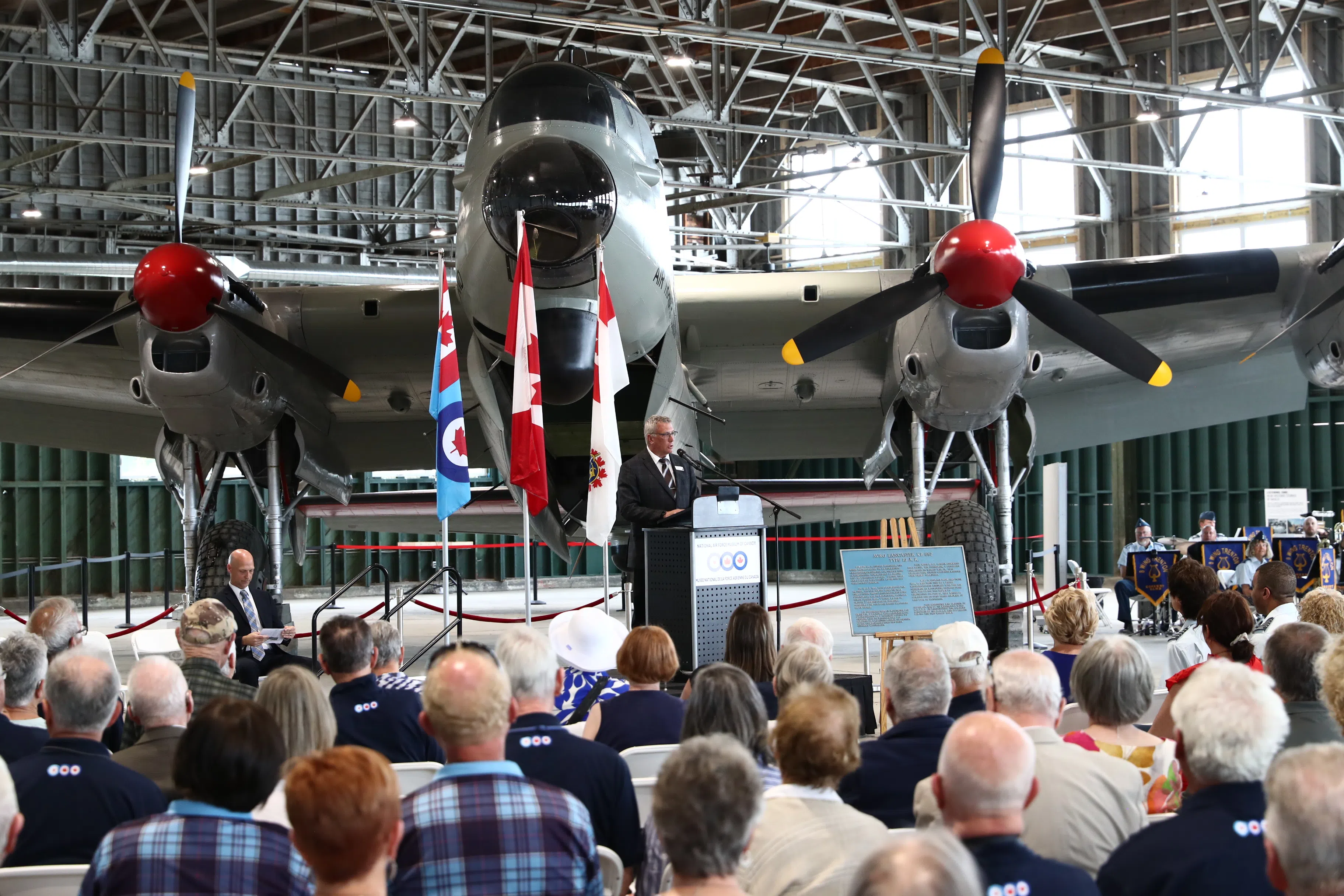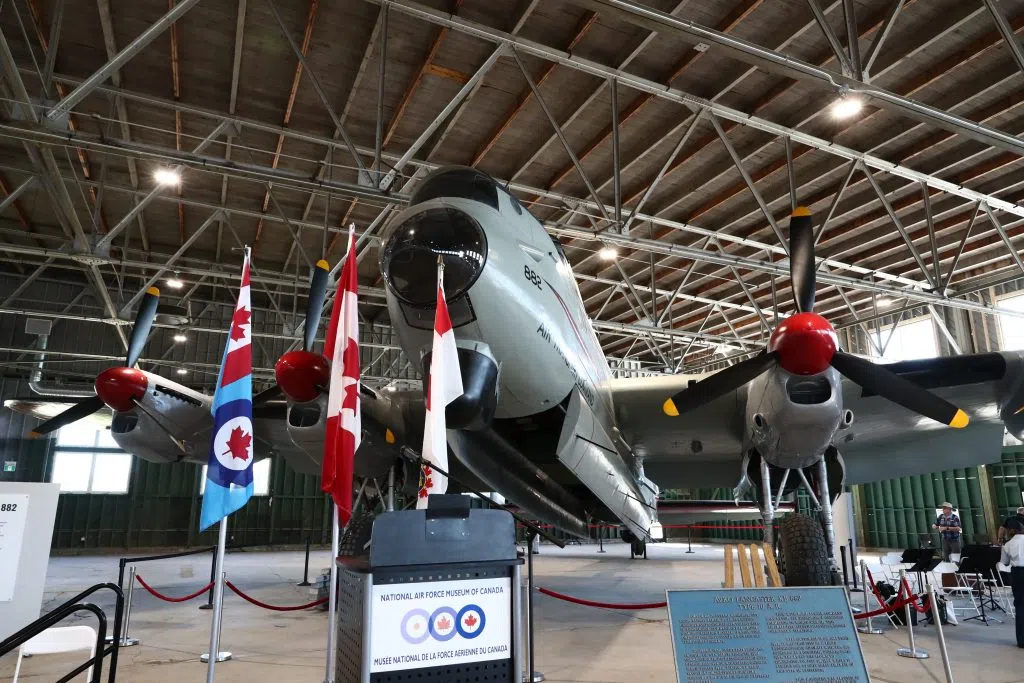The National Air Force Museum of Canada and Base31 in Prince Edward County have partnered to provide history to the Bay of Quinte region.
On Thursday, a fully restored Lancaster Bomber was unveiled to the public.
The plane was one of the most important pieces of technological equipment that Canada contributed to World War II.
On loan from NAFMC for four years, the plane will be available for viewing this Canada Day long weekend.
Also included in the viewing are activities and fun for the family.
You can get tickets and full details about seeing the plane up close and in person, along with more information by CLICKING HERE
After the long weekend, it will close to the public, as Base31 prepares to showcase their aviation museum in 2025.
A history of the Avro Lancaster Mk XAR – KB882 can be seen below
The unveiling of the Lancaster Bomber at Base31 (Photo: Iain Morton, National Air Force Museum of Canada)
Manufacturing
Victory Aircraft Ltd
The Lancaster Mk 10 was the first variant of the famous heavy bomber to be built outside of the United Kingdom (UK). Previously, Marks 1-9 were built within the UK, at a number of different manufacturing plants.
In 1943, Victory Aircraft Limited was opened in outside of Toronto. Originally the site was owned by the National Steel Car Corporation, but when the need for aircraft during the Second World War increased it became Victory Aircraft Limited, and officially switched to airplane manufacturing.
Victory Aircraft built British-designed Avro aircraft for the war effort, including 430 Lancaster Mk 10s. Lancaster KB882 was built in November 1944, and by March 1945 it had arrived in England for service.
Second World War Service
428 Squadron
As part of the Canadian No. 6 Bomber Group, Lancaster KB882 was taken on strength with 428 (Ghost) Squadron, based out of Middleton St. George, Yorkshire. From March to June 1945, KB882 participated in twelve operational missions. Eight of those missions were with the same crew, led by Flight Lieutenant W.L. Ross, pilot. A combination of both day and night bombing raids, KB882’s targets were often cities and industrial sites, including Hagen, Merseberg, Hamburg, Leipzig, Kiel and Wangerooge Island.
While KB882 survived its service in the War, it was not without incident. On April 4, 1945 Flight Lieutenant Ross had just turned the aircraft to return to England, after dropping their bombs, when rear gunner, Flying Officer W.H. Watson, spotted a German night fighter above them. Reacting quickly, Flight Lieutenant Ross put the aircraft into a corkscrew, while Flying Officer Watson fired 100 rounds at the enemy aircraft. Due to their quick thinking, KB882 received no damage.
Back to Canada
Tiger Force
As the War in Europe was almost over, eyes turned to the Pacific, where the war still raged on against Japan. In order to give as much assistance to the forces already in the Pacific, the Allies prepared to create a new Very Long Range (VLR) bomber force, code-named: “Tiger Force”. Eight Squadrons, a combination of Royal Air Force (RAF) and Royal Canadian Air Force (RCAF) personnel, would make up this offensive; flying Avro Lancasters, Avro Lincolns, and Consolidated Liberators.
In total, 141 newly built, or relatively low-time, Lancaster Mk 10s were assigned to Tiger Force, including KB882. In June 1945 the Lancaster Mk 10s that were already in service in Europe were flown to Canada, in order to be modified, painted, and crewed for Tiger Force operations.
On June 1, 1945 KB882 left England, flying first to the Azores, then onto Gander, Newfoundland, and finally into Yarmouth, Nova Scotia. 428 Squadron personnel began training in mid-July for this new Force and their anticipated campaign against Japan. Before their training could be completed, Allied leaders called on Japan to surrender. Japan refused, and the controversial decision was made to drop atomic bombs on Japan that had been developed in the United States by the Manhattan Project. On August 6, 1945 the United States dropped a 13 kiloton atomic bomb known as “Little Boy” on the city of Hiroshima, Japan. Three days later, a 21 kiloton atomic bomb nicknamed “Fat Man” was dropped on Nagasaki, Japan.
Fearful of further devastating bombings, the Japanese surrendered unconditionally on August 14, 1945. This also ended the requirement for additional Allied bomber crews in the Pacific. Tiger Force stood down, and was disbanded by October 1945. The aircraft that had been awaiting use in Tiger Force on the East Coast of Canada, including KB882, were ferried to Alberta for storage.
Cold War
Post-War Modifications
In the 1950s, the RCAF began rapidly expanding as Cold War tensions grew. Lancasters from the Second World War were pulled out of storage, modified, and returned to service. KB882 was returned to flying condition, and then sent for further modifications in 1952. DeHavilland Aircraft in Toronto modified KB882 to an Arial Reconnaissance configuration. This work was completed by 1953, when the aircraft was once again placed in storage.
KB882 was next selected to be sent to the Central Experimental and Test Establishment (CEPE) in 1956, to be used to test a new night photography system. By 1957 the installation and flight testing was completed, and the aircraft was finally ready for operational service.
408 Squadron
KB882 joined 408 Squadron on February 27, 1957. Operating out of Rockcliffe, Ontario, the squadron was tasked with tactical photo reconnaissance in support of the Army, aerial photography for map making, and Short Range Navigation (SHORAN) testing.
A large part of their duties also included Arctic reconnaissance – this could include Air Romps to assert Canadian sovereignty over the North and inspect Canadian territory, Apex Rockets to inspect and photograph Soviet ships and other items of interest that were in, or adjacent to, Canadian territory, and ice recces to provide reports on ice conditions during shipping season. The ice recces were credited with improving the safety of shipping in the Gulf of St. Lawrence which allowed for a longer shipping season at the Port of Montreal.
Lancaster Retirement
After years of technical and mechanical issues with the aging Lancaster fleet, 408 Squadron decided to retire its Lancasters. KB882’s last mission was on March 11-17, 1964 in Northern Labrador. There, it participated in the Army’s exercise Renard Bleu, which involved over 1,000 personnel, including RCAF, Royal 22nd Regiment, the Royal Canadian Regiment, the 6th Signal Squadron, and the 3rd Airborne Medical Detachment. Renard Bleu was a 24 hour per day, all-weather operation at RCAF Station Saglek, a radar station on the Pinetree Line and part of the North American Air Defence (NORAD) system.
Following this final mission, KB882, alongside Lancasters FM104, KB839, and KB976, officially retired in a ceremony at RCAF Station Downsview on April 9, 1964. The aircraft was sold to the City of Edmundston, for display at the Edmundston Municipal Airport.
Restoration
In 2017 ownership of KB882 was transferred to the National Air Force Museum of Canada. A team of Museum Volunteers and Air Force personnel from the Aerospace and Telecommunications Engineering Support Squadron (ATESS) dismantled and transported the aircraft to Trenton, Ontario. The aircraft underwent careful restoration and re-painting by a team of experienced volunteers at the National Air Force Museum of Canada. In 2024, it was moved to Base31, in Picton, Ontario, where it will be displayed for five years while the NAFMC prepares for its return.







